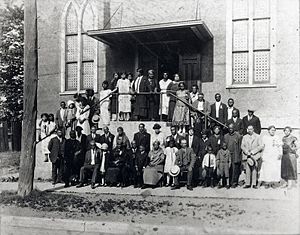British Methodist Episcopal Church, Salem Chapel facts for kids
Quick facts for kids Salem Chapel, British Methodist Episcopal Church |
|
|---|---|
| Location | St. Catharines, Ontario |
| Built | 1855 |
| Important events | Underground Railroad, Harriet Tubman |
| Designated | 1999 |
The British Methodist Episcopal (BME) Church, Salem Chapel is a very old and important church in St. Catharines, Ontario. It was started in 1820 by African-Americans who had escaped slavery and found freedom. You can find it at 92 Geneva Street, right in the middle of Old St. Catharines. This church is special because of how it looks and its strong connection to the movement to end slavery.
Today, the church has about 20 members. They hold a Sunday worship service at 11:00 am. You can also book guided tours of the church and its museum. The museum shows original documents, old items, and rare books. All these things tell the story of the fight against slavery.
A Look Back: The Church's History
The Salem Chapel was a key place for people fighting to end slavery and for equal rights. It was the heart of a growing community of African-Americans who had fled the United States.
The most famous person connected to the church was Harriet Tubman. She lived in the area from 1851 to 1858. Harriet Tubman was a brave leader who guided many people escaping slavery to freedom. She used a secret network called the Underground Railroad (UGGR). Many of these journeys ended safely in St. Catharines, Ontario.
In 1851, the church was known as Bethel Chapel. It was part of the AME Church. At first, it was a small building made of logs. This building was built by the black freedom seekers themselves. By 1853, more people were settling in the area. So, the church decided they needed a bigger building.
In 1850, a new law called the Fugitive Slave Act was passed in the United States. This law made it very risky for former slave preachers to travel to church meetings in the U.S. They feared being captured and forced back into slavery.
Reverend Benjamin Stewart suggested that churches in Canada should form their own group. This idea was accepted at the AME Church's meeting in 1856. They chose the name British Methodist Episcopal Church. This name showed that British America (Canada) was a safe place away from slavery.
At a Canadian meeting in 1856, some AME Churches changed their names. The Bethel Chapel in St. Catharines was one of them. In 1957, Bethel was renamed the Salem Chapel.
Why This Church is Important
The Salem Chapel was named a National Historic Site in 1999. This means it's a very important place in Canada's history. Outside the church, you can see several signs and even a statue of Harriet Tubman.
The church is important because of its strong ties to the anti-slavery movement. It also shows the early history of the black community in Canada. The church's design, with its open meeting hall, was common for early African Canadian churches.
There are different historical markers at the site. A provincial sign honors Harriet Tubman. A city sign talks about the building itself. Later, the national Historic Sites and Monuments Board put up two more signs. One marks the chapel as a national historic site. The other honors Tubman as a national historic person.
How the Church Looks: Design and Architecture
Salem Chapel is a well-kept, three-level church. It has a gable-fronted design, meaning the front wall is shaped like a triangle. It sits on a tall foundation. The building is covered in stucco. It has simple, evenly spaced windows that are shaped like pointed arches.
The chapel has an "auditory-hall" design. This means the inside is one large room, perfect for everyone to hear the preacher. This style was typical for churches connected to the Underground Railroad.
Here are some other important features of the church:
- The main entrance is in the middle of one end of the building. It's between two large pointed-arch windows. You reach it by a split staircase.
- There are four pointed-arch windows on each side of the church, spaced out evenly.
- It's built with wood, has wood trim, and a stone foundation.
- It has a tall basement.
- The inside is simple. There's a restored, hand-painted pattern around the top gallery.
- Some of the original furniture is still there, like the long benches made from a single piece of walnut wood.


